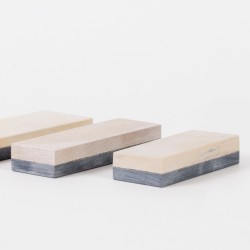Ardennes-Coticule
The sole producer of the famous "coticule" razor stone and Belgian blue stone.
Ardennes Coticule has been awarded the "Handmade in Belgium" label. This label proves that all their stones:
Are 100% handmade
Are traditionally made
Are made locally
Are unique
Its history:
Until 1865, whetstones were mainly produced by private individuals and local farmers. These stones were used to sharpen their razors, knives, scissors, axes, gouges and chisels, etc.
After 1865, the reputation of Coticule stones spread beyond the region's borders. It was at this time that Mrs Denise Burton-Walrant lost her husband at a very young age and decided to set up her own business, which she called Burton. By 1900, she was selling whetstones in Belgium, Germany, France, Italy and England.
In 1954, two brothers descended from the family, Prosper and René, took over the business. They sold whetstones practically all over the world: Europe, USA, Saudi Arabia, Egypt, Congo, India, Mexico, Argentina and Chile. Shortly afterwards, the arrival on the market of electric razors and artificial whetstones competed with natural stones, causing a significant drop in sales.
In 1979, René died, leaving Prosper sole owner of the company. The company then had just 2 workers in the mine and 2 in the workshop. After Prosper's death in 1982, 117 years after the start of the Burton company, production came to a halt.
Four years after Prosper's death, five geologists and mining engineers returned to the business to carry out small-scale production at weekends. One of them, Maurice Celis, became the founder of Ardennes-Coticule.
In 1998, he decided to continue the adventure alone and on a full-time basis. As in the history of the Burton family, the watchword was to work very hard to maintain the good reputation of Coticule throughout the world and to promote its exceptional character. In order to maintain the market for Coticule, he had to devise a plan to sell the by-products from the extraction of the deposit to various industries and private individuals. He discovered that the blue shale layers had similar sharpening properties to yellow Coticule. It was at this point that he developed Belgian Blue Whetstone.
5 produits trouvés





